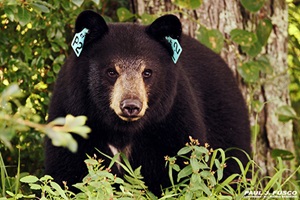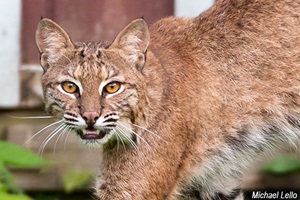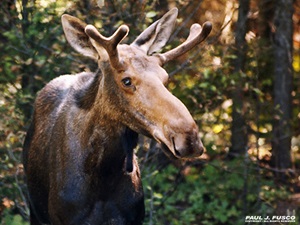Report a Wildlife Sighting
The DEEP Wildlife Division collects sighting reports of various wildlife species to help with ongoing research projects, as well as to track distribution and abundance of certain populations. You can help by reporting your observations for the wildlife species listed below.Black Bear | Bobcat | Moose | Gray Fox | Fisher | Sightings for Wild Turkey Research | Endangered Species | Ruffed Grouse | Wild Turkey Broods | Bald Eagle Nests | Bats | Dead Birds | Marine Mammals and Sea Turtles | Coastal Sharks
View a map of current sightings for black bears, bobcats, and moose
If you wish to view sighting totals per town of bears and bobcats from the previous year, select the first i at the top right of the map viewer (see red circle in the image).

Report a Bear Sighting

Select the link above to report your sighting. The Wildlife Division has been conducting a long-term study of the state's growing black bear population. Some bears have been marked with ear tags and GPS collars as part of our research. Sighting reports provide important insight about the distribution and abundance of bears throughout the state, while also providing information about any conflicts or concerns. Visit our Living with Black Bears webpage to learn more about bears in Connecticut.
As part of this long-term study, the public is also asked to report vehicle-killed bears seen along Connecticut roadways by calling 860-424-3011. Examination of road-killed bears helps the Wildlife Division learn more about black bear population dynamics around the state.
For bear-related emergencies, please call DEEP's 24-hour Dispatch Center at 860-424-3333.
Report a Bobcat Sighting

Select the link above to report your sighting. The Wildlife Division initiated a study of Connecticut's bobcat population in 2017. Bobcats were live-trapped and marked with yellow ear tags and GPS collars. Sighting reports of bobcats will help biologists gain an understanding of the current state population.
The Division also collects carcasses of road-killed bobcats as part of the study. Roadkills can be reported to 860-424-3011.
Report a Moose Sighting

Select the link above to report your sighting. Moose sightings in Connecticut have been monitored since the early 1990s. Annual sightings of cows with calves since 2000 confirm the establishment and expansion of a resident population. Moose sighting reports help biologists monitor the presence of this large mammal in our state. The current population is estimated at just over 100 animals. Read our Moose Fact Sheet to learn more about moose in Connecticut.
Report a Gray Fox Sighting

Select the link above to report your sighting. The Wildlife Division is increasing its monitoring efforts of gray fox to better understand the species' distribution and relative abundance throughout Connecticut. Sightings of gray foxes can be submitted using the survey form. Photos are not required but are helpful for confirmation. You may submit links to cloud-based photos in the "Additional Comments" section. Report vehicle-killed or other deceased gray foxes to 860-424-3211 so they can be collected for research. Gray Fox Fact Sheet
Report a Fisher Sighting

The Wildlife Division is collecting sighting reports to help monitor Connecticut's fisher population. The fisher is a large member of the Mustelidae (weasel) family that prefers large tracts of coniferous or mixed hardwood-softwood forests. Report your observations to deep.FisherSightings@ct.gov. Be sure to include the date, time, location, and any photos or video of your sighting. Please note that many people claim to have heard fisher calls that sound similar to a person "crying". In reality, those calls are most likely coming from a red fox (fishers are not very vocal). Report vehicle-killed or other deceased fishers to DEEP's 24-hour Dispatch Center at 860-424-3333 or deep.dispatch@ct.gov so they can be collected for research.
The Wildlife Division is currently conducting a research project on fishers, and you may see some fishers with radio collars. Please report any radio-collared fishers to deep.FisherSightings@ct.gov or 860-424-3722.
Report Wild Turkey Sightings for Research
The DEEP Wildlife Division is initiating a wild turkey research project in 2025. Staff biologists are seeking observations of wild turkeys for the purposes of live-trapping birds to research hen, nest, and poult survival, harvest rate, and disease prevalence. Please submit your wild turkey sightings.
Report Endangered Species
DEEP's Natural Diversity Data Base is collecting sighting reports and information on the location of state-listed species (plants and animals, including invertebrates).
Report Ruffed Grouse
All members of the public are asked to report grouse sightings, which may consist of actual bird observations or drumming activity. To report grouse sightings, please contact Wildlife Division biologist Will Cassidy at william.cassidy@ct.gov or 860-418-5961.
To obtain grouse distribution and harvest information, the Wildlife Division is asking grouse hunters to submit hunting reports through the Ruffed Grouse Hunter Log.
Wild Turkey Brood Survey
Select the link above to learn more about the survey. The Wildlife Division encourages residents to participate in the annual Wild Turkey Brood Survey to help biologists estimate the average number of turkey poults (young-of-the-year) per hen statewide and to assess annual fluctuations in the turkey population. From June 1 to August 31, volunteers are asked to record all of the hens, poults, and toms or jakes (males) observed during normal travel (please only submit sighting reports during June 1 and August 31). To participate, use the online form (form will be live on June 1) after each turkey brood sighting. As in previous years, paper copy submissions will still be accepted at the end of the season -- please submit paper copies starting September 1. Download a Wild Turkey Observation Form to record your observations (instructions are found on the data sheet).
Report Observations of Bats
Select the link above to report bat observations. Connecticut's bat species have suffered dramatically from the effects of white-nose syndrome to the point that several are now on Connecticut's List of Endangered, Threatened, and Special Concern Species. Whether you have seen a bat out during winter; one or more roosting in your bat house, barn, or eaves during summer; or even a dead bat, the Wildlife Division wants to hear about it. Submit a Public Bat Sightings Form to record your observations or email deep.batprogram@ct.gov.
Report Bald Eagle Nests
The DEEP Wildlife Division monitors nesting bald eagles in Connecticut. Almost all information about new nests and the status of existing nests comes from volunteers. This information is critical to allow the Wildlife Division to protect individual nests and Connecticut’s bald eagle population.
Report Dead Birds
If you see several dead birds (>5) in one location or notice that several birds die in the same area over the course of several days, this is a situation where testing of the dead birds may be warranted. If you observe this type of die-off, in addition to filling out this form, please call the DEEP Wildlife Division at 860-424-3011.
Content last updated in October 2025.

